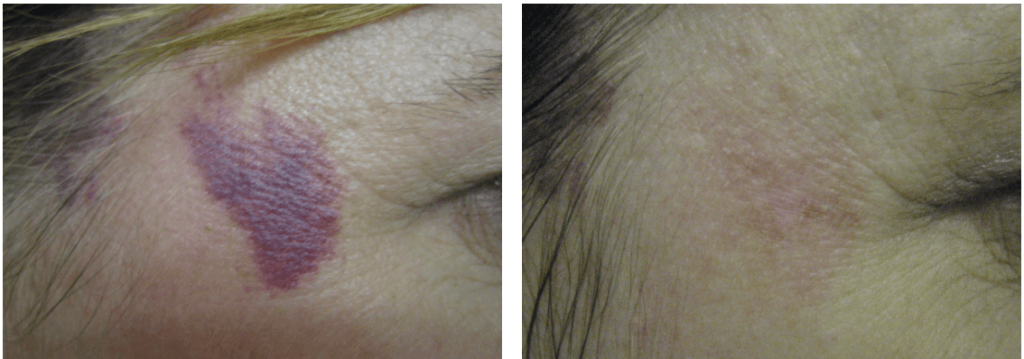Port-Wine stains are red or purple marks, often on the face. They are caused by a localised area of abnormal blood vessels.
Treatment of port-wine stains with lasers can give good or excellent results. At Cheshire Lasers we find 4 to 10 treatments are needed to achieve results. The number of treatments required depends on the size, the colour and the response of the birth mark to the treatment. Camouflage creams such as lycogel are also an alternative treatment.
Here is an example of a Port-Wine Stain Reduction treatment performed at Cheshire Lasers Clinic.
Treatment works best the younger you are, at Cheshire Lasers most of the clients we have treated so far have been in their 30s and 40s and we have still had good to excellent results. Treatments tend to work less well in adults who have had a port-wine stain for many years and it has become bumpy and raised.
Treatment tends to work best on smaller port-wine stains of the face and less well on the arms and legs. Generally, the paler the port-wine stain, the greater the chance of excellent results with less treatments.
The laser or IPL treatment can cause an unpleasant stinging. Treatments are given about 4 to 6 weeks apart. There may be pain, bruising and swelling over the treated area for a while after each session.
What is a Port-Wine Stain?
A port-wine stain is a red or purple mark on the skin. It is usually present from birth. About 3 in 1000 babies are born with a port-wine stain. Most occur on the face but any area of the skin can be affected. Port-wine stains affect males and females equally. They are not hereditary.
What do Port-Wine Stains look like?
Port-wine stains vary in size from a few millimetres across to many centimetres. Their colour can vary from pale red to deep purple. If left untreated, port-wine stains tend to darken over the years as the blood flow through them becomes more sluggish. The overlying skin is smooth and flat at first. By middle age the overlying skin can become thickened and lumpy (a ‘cobblestone’ appearance).
What causes Port-Wine Stains?
A port-wine stain is a localised blood vessel problem. The tiny blood vessels (capillaries) in port-wine stains remain dilated (wide). It is like a permanent localised blush. The reason why this occurs is thought to be due to a damaged or faulty nerve supply to the affected tiny blood vessels. The nerve impulses that make the blood vessels narrower are lost so they then stay wide all the time.
What are the symptoms of Port-Wine Stains?
Apart from their appearance, no other symptoms or problems occur in most cases. However, about 1 in 10 babies born with a port-wine stain on the face have problems of the eye or brain. * Eye problems may develop if the port-wine stain is on the eyelid area. If a child has a port-wine stain next to an eye then an eye specialist will normally check the child regularly until they are adult. * Brain abnormalities are an uncommon association with port-wine stains of the face. This is due to extensive blood vessel abnormalities in the brain, (The Sturge-Weber syndrome), Epilepsy and other problems may then develop. The majority of children with port-wine stains do not have these complications.
View our Prices for Laser Port Wine Stain Treatment here

